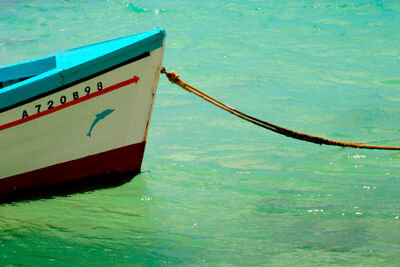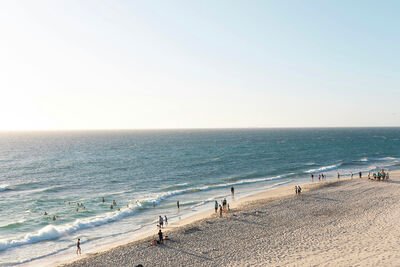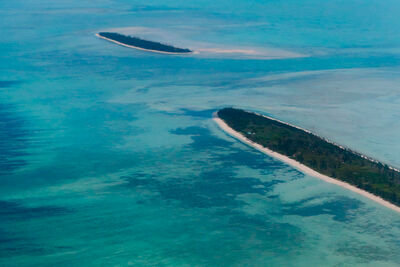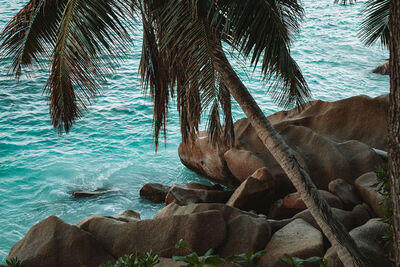The Indian Ocean may be smaller and younger than its siblings - the Pacific and Atlantic - but don't underestimate the wonders of this tropical body of water. Known for its warm waters that are rich in biodiversity, varied in underwater topography and swarming with some of our marine favourites - we're talking manta rays and dugongs - it also has some interesting and unique features. So, if you want to learn a thing or two about the Indian Ocean - such as why its current changes - then read on for our top ten facts on the Indian Ocean.
1. The Indian Ocean covers one fifth of the Earth
Let's fin off our Indian Ocean fact file by addressing the size of this ocean. The Indian Ocean is the world's third-largest ocean and covers around one fifth of the Earth's surface. It spans over 27 million square miles, which, to put into perspective, is roughly five times the size of the United States.

2. The Indian Ocean is the smallest but most complex of the three major oceans
Despite its size, the Indian Ocean is dwarfed by its bigger siblings (the Pacific and Atlantic), making it the smallest of the three major oceans. It's also the youngest and most geologically and physically complex, but more on that in a minute...
3. The Indian Ocean was formed by the breakup of Gondwana
As we just mentioned, the Indian Ocean is the youngest of the major oceans and its formation began around 180 million years ago with the breakup of the supercontinent Gondwana. The northward drift of the Indian subcontinent, its collisions with Eurasia (about 50 million years ago) and the separation of Australia from Antarctica all played a role in the shaping of the ocean's basin. While the ocean may have first began to open around 140 million years ago, most of its seafloor is less than 80 million years old - that's young in terms of Earth's geological timeline.

4. The Indian Ocean stretches from Africa to Australia
As we mentioned before, the Indian Ocean covers a large distance. It stretches over 6,200 miles from the southern tip of Africa to Australia. It's bordered by Asia to the north, Africa to the west and Australia to the east and stretches down to the Southern Ocean in the south. An interesting fact about the Indian Ocean is that there is no universal agreement on its southern boundary. Many researchers separate the Indian from the Southern Ocean according to a 60°S latitude but some authorities argue that it extends all the way to Antarctica. We'll leave it with you to decide what camp you sit in...
5. The deepest point of the Indian Ocean is in Java, Indonesia
The Indian Ocean has an average depth of 3,741 meters, with its deepest point being in the Java Trench. Here the sea floor plunges to 7,450 meters off the southern coast of Java, Indonesia.
6. Its currents reverse annually
A unique fact about the Indian Ocean is that the water currents in its northern part change direction twice a year. This happens because of the monsoon winds - caused by temperature changes from land and sea - that change direction with the season. The northern part of the Indian Ocean is bound by countries in south Asia and since no other ocean is surrounded by such large landmass, this current reversal is unique to the Indian Ocean.

7. The Indian Ocean is dotted with many islands
The Indian Ocean is home to many large island countries such as Sri Lanka, the Maldives and Madagascar, but did you know that it also has some of the world's smallest territories? Cocos Keeling Island - a remote territory of Australia - has a population of around 600 people, meanwhile Tromeline Island (a French territory) is uninhabited, apart from the occasional scientist and meteorologist. This island has a few stories of its own, including a tragic and remarkable story from the 1700s. In 1761 a French ship that was carrying slaves was wrecked on Tromeline Island, and while the French crew was saved quickly, around 60 enslaved people were left behind. 15 years later a French rescue mission returned and amazingly found a few survivors - seven women and one baby boy. These people had survived the 15 years by building shelters and living off the sandy island's limited resources.
8. There are biodiverse hotspots within the Indian Ocean
The Indian Ocean has low levels of plankton and so has less overall marine life in the ocean compared to the Pacific or Atlantic. While the main body of the ocean may be lacking in marine life, specific hotspots make up for this with some incredibly diverse ecosystems. For example, the Maldives are home to nesting and feeding grounds for ocean- manta rays, while Ningaloo Reef (on Australia's West coast) provides feeding grounds for dugongs, a rare marine mammal that was once mistaken for a mermaid. And for some big boys, head to Madagascar, a key breeding ground for humpback whales; each winter around 7,000 humpbacks migrate here to breed and calf before heading to the cooler polar waters to feed on krill in the summer.

9. The Indian Ocean is full of colour
The Indian Ocean contains around 30% of the world's coral reefs, with some of the most colourful corals being found in the Maldives, where you can find over 2,000 species of corals. If you're looking for fifty shades of brown head to Ningaloo Reef, or if coral-encrusted granite rock formations are your thing, then you must dive in the Aldabra Atoll, a UNESCO World Heritage site in the Seychelles.
10. There are prehistoric fish in the Indian Ocean
Let's end our Indian Ocean fact file by highlighting some of the rarest, and oldest marvels found in these waters. The coelacanth, a prehistoric fish that was once thought to be extinct, has been spotted off Tanzania's coast. This fish can be traced back 420 million years and gives us an indication into the evolution of fish to four-legged land animals. And if you want to spend some time with some elderly animals, then seek out the Aldabra Giant Tortoise in the Seychelles. Found in the coastal mangroves and swamps of the Aldabra Atoll, this tortoise can live up to 200 years, in fact one made it to 225!
















